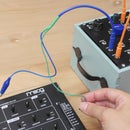Introduction: Back to the Future Part II : Auto-adjusting Jacket
The day has come, the year is here and the future is now. In Back to the Future Part II, Marty and the Doc travel to the near future, what date do they arrive on? October 21st, 2015.
My love for dynamic wearables and the movie Back the Future Part II sparked the desire to make Marty McFly's auto-adjusting jacket a reality. Taking a glimpse into a future where auto-sizing garments can exist, the jacket sleeves start off too long, then go up as if they are auto-adjusting to the correct size. This happens by using a 3D printed pulley mechanism and micro gearmotors. When a button on the jacket hem is pushed, cables are wound around a pulley, drawing the sleeves up. The cables are threaded through a simple tube system built inside the jacket and sleeves.
Big thanks to JON-A-TRON for collaborating with me to make the pulley mechanism a reality. The design of the mechanism is adapted from Paolo Salvagione's 3D printed bearing with driven miter gear.
Step 1: Gather Materials
I started with a bought jacket as a base to build on. Any jacket can be used that has sleeves. It's best to start with one that is made from heavier material, such as real or faux leather. The mechanism will be sewn to it and a bit of force will be applied. A thin material may sag and not perform well under pressure from movement.
The gears are left exposed, if I were to design a garment from scratch a place for them to be hidden could be designed in as well. For this project, something would need to be added, such as a hood or maybe a back pack. In my opinion, adding a cover to the mechanism would add unnecessary bulk plus the gears look very cool on their own.
Jacket and Sleeve Materials + Tools
- Halloweencostumes.com BTTF 2 Jacket : Mine is a size Medium
- 3 yards of grey polyester poplin
- 5 to 8 yards of medium weight black fusible interfacing (yardage depends on width).
- 2 yards of stiff fusible, the stiffer, the better. I found some that was a non-woven and was laminated. It felt like plastic and worked very well.
- 2 three yard packs of 1" double fold binding in Lt. Grey
- Ribbed black vinyl runner : Get enough to cover 2.5" x 40" (jacket hem) and 1.25" x 20" (jacket cuffs). It can be found at a local hardware store in different widths and sold by the foot.
- 3 yards of 3/16" clear vinyl tubing : I found some at my local hardware store.
- Strong braided cord : I used fishermen sinking braid called TUF- Line
- 2 red square tactile switches (one is just for show)
- 1 DPDT rocker switch
- 1 yellow or orange LED
- Heavy-duty red thread
- 1/4 yard of black eye tape (you do not need the hook side)
- Small piece of red and grey leather
- Heavy-duty hand needles
- Seam ripper
- Sharp scissors
Mechanism Parts
Hardware from McMaster-Carr, low-power gear motor from Pololu.
#96415K71 316 Stainless Steel Precision Ball, 1/8" Diameter
#94150A305 Metric Type 316 Stainless Steel Hex Nut, M2 Size, .4mm Pitch, 4mm Width, 1.6mm Height
#90116A007 Metric 316 Stainless Steel Pan Head Phillips Machine Screw, M2 Size, 3mm Length, .4mm Pitch
#90116A020 Metric 316 Stainless Steel Pan Head Phillips Machine Screw, M2 Size, 10mm Length, .4mm Pitch
#92000A001 Metric 316 Stainless Steel Pan Head Phillips Machine Screw, M1.6 Size, 3mm Length, .35mm Pitch
2 #1097 150:1 Micro Metal Gearmotor
Access to:
- 3D printer
- Sewing machine
- Laser cutter
- Walking-foot sewing machine for sewing on black vinyl hem and cuffs.
Step 2: Take Apart Jacket
- Cut both of the middle accordion pieces from the jacket on both sleeves. These will be replaced as well as give you room to install the tubing and cable system.
- Put Fray Check along the cut edges on the remaining pieces to prevent fraying.
- Cut off zipper and toss.
Step 3: Lots of Rings
Each sleeve has two accordion billows that contract and expand. To help the mechanism be successful and to maintain the accordion structure the billows need to have some stiffness. To create some, all of the rings get fused with medium weight interfacing except for the rings at the ends of each section, those get fused with the very stiff interfacing. The end rings being so stiff will help with sagging when the billows are in up mode.
Since there are a lot of circles, laser cutting them is the best and most accurate way to get the job done. The laser also prevents the edges from fraying from the heat of the laser.
Using the attached vectors, cut the following:
Grey Polyester Poplin
16 x Bicep
24 x Lower arm
Black Fusible
12 x Bicep
20 x Lower arm
Stiff Fusible
4 x Bicep
4 x Lower arm
Iron the stiff fusible on 4 of the bicep and 4 of the lower arm circles. The rest get fused with the medium weight interfacing.
Step 4: Sew Accordion Sections
Sew two accordion segments for each sleeve. All seams are topstitched with 1/8" seam allowance. The lower arm circles are slightly smaller than the bicep rings and made to fit my jacket and arm circumference. You may want to resize to fit yours.
Lower Arm
- Cut off two eyes from the tape and put them in the middle of each stiff outer ring (4) and pin in place.
- Make 12 pairs of rings, placing the right sides of the fabric together, fusible side out. 6 pairs for each sleeve. Make sure that each of the super stiff rings gets paired with a medium weight one.
- Sew the inside of each pair together, catching the eye tape on the 4 rings they are pinned to.
- Sew the pairs together along the outer edge. Place the 2 stiff rings on the ends, with 4 pairs in the middle for each sleeve. On each segment, line up the eyes at each end before sewing.
Bicep
Construct the bicep accordion in the same way, minus the eye tape. Each bicep segment will have 4 pairs.
Step 5: Print Parts
Print 2 of all the mechanism parts and the Y connectors.
Step 6: Build and Place Pulley Mechanisms
Build
- Fit the outer race onto the sewable attachment, then fit all 6 nuts into place on the back.
- Take 4 10mm screws and fasten outer race to attachment.
- Screw the mount on the motor.
- Screw that in place using the remaining 2 holes.
- Press fit the small bevel gear on the shaft of the motor. The tip of the shaft should be flush with the gear.
- Take the pulley bevel gear and place it in the middle, it will take some wiggling around to see how to get the gear past the motor. Take your time and be careful not to apply to much pressure as to break the parts.
- Turn over and roll in the ball bearings.
- Take the inner race and screw that down.
Place
Put both of the pulleys on the center back of the jacket. Use some chalk to create an outline and mark where the thread will go through.
Step 7: Prep, Cut and Place Tubing
To make the tubing sewable, it gets sandwiched in between the binding and sewn in like piping. Do this for the whole 3 yards.
The mechanism works by tying cables to the end of the lower arm segments and pulling them up by winding up the cable around a pulley. The cable runs through the plastic tubing. The 150:1 motors can handle the weight, but the goal is to minimize any friction the cable may experience. Friction is added by any curves the cable may have to travel along, so create a straight line as much as you can with the tubing starting from the top of the jacket to the bottom of the sleeve. Make any curves as long and soft as possible.
Tubing
The diagram above shows where they were placed.
A long piece of tubing goes from the mechanism, through the bicep accordion and into the middle section about 2". Run it along the underarm seam.
The edge towards the mechanism goes from the inside to the outside. Poke a hole next to where you marked the pulley with an awl. The finished hole should be big enough to push the tubing through from the inside of the jacket to the outside. Finish the hole off with a leather facing. Push about an 1" length through. Pin the tubing to the underarm seam of the sleeve cap and right by the mechanism, leaving the rest loose.
Attach Bicep Billow
Pin and sew the outer edge of the end ring to the sleeve cap. Top stitch 1/8" from the edge. Do the same to the bottom of the accordion, lining up the velcro strap with it's velcro mate.
Pin and sew the middle sleeve section to the bottom of the bicep billows, lining up the underarm seam with the sleeve cap's.
Pinch the billows together under the arm in the pit and tack closed with a 2" stitch line. Pin the tubing directly below the billows, secure with pins and cut leaving about 2" length. Use a piece of leather strip over the tubing to straighten the short length along the sleeve seam, if needed.
Step 8: Finish Sleeve
After the middle section is attached, the tubing then breaks into a Y using a connector and the short pieces are softly arched towards the position of where the eyes will be. The eyes want to be positioned 90 degrees from the underarm seam, opposite of each other.
The seam allowance on the tubing created by the binding gets sewn to the jacket. Don't sew the whole length to the jacket, tack the long piece on the inside by the mechanism and leave the rest hanging until it reaches the arm hole.
Thread Cable
Starting from the top of the jacket, thread two long pieces of cable through until it come out of the tubing. It's easier if the Y is disconnected to get it through to both sides.
Once each piece of cable is through a leg of the connector, pull each of them through a short length of tubing and and pop the connector back on. Secure with hot glue.
Use a piece of tape to fasten the cable ends to the top back of the jacket as you do this, leaving at least a foot of length.
Attach Lower Arm Billow
Thread one piece of cable through each pair of eyes on the lower arm accordion. Pin the lower arm billows on and sew around the top end ring. Leave the cuff off for now.
Put the jacket on a mannequin and pull the sleeves down to their longest length. Be careful not to pull the cable through the tubing entirely.
Once the sleeves are at their longest, tie each string to the bottom eye.
Step 9: Attach Cuff and Test!
Once the sleeve is constructed test the drag weight by pulling the cable from the top. It's ok to have some weight and should feel like one smooth movement. Be aware of any extra drag or snags that may be caused by tight curves in the tubing or getting stuck on straight pins.
When ready, thread the two cable ends through the channel above the motor and through the two holes on the pulley. Apply some power to one of the motors and watch the cables pull up the sleeve. If everything looks good, knot the cable, clip the end and use glue on the knot to secure it.
Step 10: Add Details
- Sew the center front edges with grey binding.
- Cut the ribbed vinyl to the length of the hem, minus the width of the bound center, and double the width. Fold it over the hem and stitch in place using a walking-foot. Alternatively, cut the vinyl the exact width of the hem, rather than double, and hand sew on. The vinyl is softest between the ribs.
- Cut a single layer of vinyl for the cuffs and sew those on.
Step 11: Add Switch and Battery Holder
Make a pocket for the battery holder from some scrap fabric and sew it inside the jacket where it seems comfortable.
Cut a small rectangular piece of grey leather to fit next to the hem on the bound center front. Punch a hole in the middle for the LED and openings a little smaller than the switch tops. Push the components through and glue them to the leather from the back.
Step 12: Wire It Up!
This is as simple as it gets. A switch is put in series between the motors and power. When pressed, it allows power to flow through to the two motors. A next step would be to use a motor driver so the motors get regulated and constant current and voltage.
As it is now, the motors with turn slower in relation to the battery continually draining. Four AAs were good for at least 10 up and down motions.
Switching the polarity of the motors will cause them to turn the other way. Use a switch and install that in the jacket. As it goes down, tug a bit on the sleeves to make sure cable slack isn't left alone with the mechanism, you want to make sure there is no chance of it getting caught.
That's it! I'm excited about the possibilities the mechanism brings. I've always wanted to create moving fashion, skirts that change length, and dresses that change shape. Let me know if you have any questions and if you enjoy the project in the comments!

Participated in the
Halloween Costume Contest 2015

Participated in the
Back to the Future Contest

Participated in the
Halloween Props Contest 2015





















